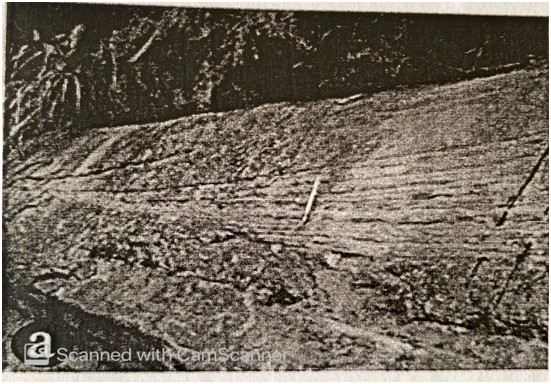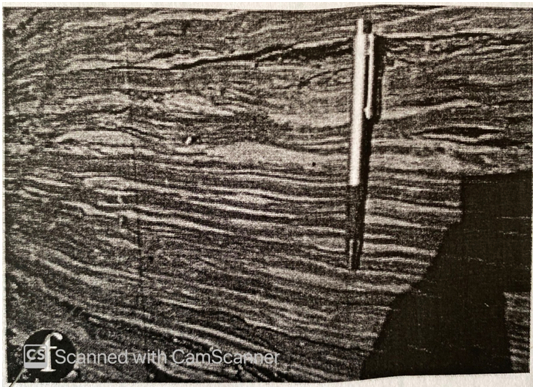Bhuban Fm
Type Locality and Naming
Lower formation of Surma Gr. The type section is in Hilara-Katigara section, north of the Barak River. P Evans designated the lower unit of his Surma Group as the Bhuban Stage after the Bhuban Range (24°40'N; 93°02'E) of Assam, India. B Biswas has emended this sequence to formation rank. [Original Publication: Evans, P. (1932) Tertiary succession in Assam, Trans. Min. Geol. Insti, India, Vol. 27, pp: 173-200.]. Reference well: South Badapur well -1, and Silchar Haflong road section.
[Figure 1: Geological set up and formation stratotypes of North East Basins (modified after Pandey and Dave, 1998)]
Lithology and Thickness
Sandstone and claystone. The formation is divided into three members – lower sandy, middle clayey and upper sandy. There is marked representation of grey and buff colored sandstones in all three units of Bhuban Formation, which are highly bioturbated.
Lower Bhuban: Thick succession of alternating sandstones, siltstones and shales.
Middle Bhuban: A thick succession of shales with siltstone and sandstones.
Upper Bhuban: Thick sequence of sandstones alternating with shales.
It shows great variability in thickness. The maximum thickness is in the subsurface of Tripura and Cachar where it is more than 3000m thick.
[Figure 2: Field Photograph of Tidal bundles in Buff sandstone in Tuirial section (after Paul Lalnuntluanga et al., 2014)]
[Figure 3: Field photograph of Thinly laminated sandstone-shale alternations with parallel lamination in Tuirial section. (after Paul Lalnuntluanga et al., 2014)]
Relationships and Distribution
Upper contact
Gradation contact with the Bokabil Fm.
Regional extent
Khasi & Jaintia Hills, Naga Schuppen Belt, Tripura Cachar, SE Bangladesh, NW Bangladesh: It is exposed in Tripura-Cachar fold belt, from the Dauki Fault till the Arakan Coast. In the east the Kadi Fault (in Manipur) marks the limit. It continues to the west of Cachar and Tripura into the subsurface of Bangladesh. It is present in the southwestern part of the Schuppen Belt. In Bangladesh, outcrops occur throughout the Frontal Folded Belt and particularly in the cores of anticlinal trends in the eastern part of the Chittagong Hill tracts. Further outcrops are known from three northern margins of the Surma Basin between the Atgram area in the east and Jaintiapur in the west, where the outcrops parallel the E-W trend of the Dauki Fault.
GeoJSON
Fossils
Baruah et al., (1996) reported Globorotalia praebulloides, G. obesa, G. peripheroronda, G. siakensis, Neogloboquadrina continuosa, Globogerina falconensis. Globigerinoides immaturus, G. trilobus from the Middle Bhubhan Formation and a species of Globigerinoides from Upper Bhubhan unit at Well Bhubandar-A from Cachar area, Assam. Jaruah et al., (2003) reported two species of foraminifera viz Pseudotaberina malabarica and Borelis pygmaeus from Upper Bhubhan Formation of Mizoram. Ramesh, (2004) reported abraded benthic foraminifera of Uvigerina flinti, Baggina sp., Ammonia umbonata, Roephax, Haplophragmoides suborbicularis, H. stomatus, Karrerulina conica and Trochamminoides folius from lower Bhubhan unit at well Badarpur-L (BP-L). He also reported foraminifera of Globorotalia mayeri, Gl. continusa, Globogerinoides bisphericus, Globoquadrina altispira, Globigerina praebulloides, rare Uvigerina javana, Baggina, Recurvoides, Cyclammina, Bathysiphon, Gerochammina, Reophax and radiolarian at well Badarpur-L (BP-L) from Middle Bhubhan unit from subsurface of Cachar area, Assam. Lokho and Raju, (2007) reported the assemblage of Ammonia umbonata, Baggina sp., Clavatorella sturanii, Lagena sp., Orbulina bilobata (d’Orbigny), Praeorbulina glomerosa circularis and Praeorbulina transitoria.
Though most of these rocks are sandy and clayey, the intermittent calcareous units have provided moderately preserved nannofossils. It has been possible to precisely date several nannofossil-bearing horizons from widely separated sections. Samples from two levels in the Ruata quarry situated ~12 km west of Aizwal city has yielded late Burdigalian-early Langhian (=Early and Middle Miocene) age nannofossils of NN2-NN4 nannofossils zones and Messinian age nannofossils (=late Late Miocene) of NN11B-NN12 zones of Martini (1971) of late Miocene/early Pliocene age. Two samples from Turial Bungalow section have yielded calcareous nannofossils belonging to broad NN2-NN8 zones of Late Miocene time slice and NN13-NN19 zones belonging to latest Tortonian/ Messinian (=Late Miocene) boundary. Only one productive sample from the Tuirial prayer point section has yielded nannofossils of late Burdigalian - early Langhian age (NN5 - NN11 zones of middle Miocene age). (after J.Rai et al., 2014)
[Figure 4: Summary chart of Neogene Litho-Bio-Chrono-Sequence Stratigraphy and settings in North East Regions, India (modified after Raju and Lokho, 2017)]
Age
Depositional setting
Additional Information
The unit is a natural gas bearing horizon in Bangladesh.
Four magneto-stratigraphically constrained isolated sections in the Mizoram part of the Surma basin have been successfully correlated, namely, (1) Kolasib-Rengtekawn (KR) section in Kolasib district; and (2) Bawngkawn-Durtlang (BD); and (3) Turial and (4) Sairang sections in Aizawl districts of Mizoram. The youngest magnetozone of BD section i.e., C5Cn magnetozone (16.726-16.014 Ma) has also been recorded in the KR section and both the sections expose Middle Bhuban Unit of Bhuban Formation, Surma Group. Thus KR section is correlated with the upper part of BD section. Three younger magnetozones, viz., C4An (9.025 - 8.70 Ma), C4Ar.1n (9.31 - 9.23 Ma) and C4Ar.2n (9.64 - 9.58 Ma) of Turial section have been delineated in the Sairang section and both the sections belong to Upper Bhuban Unit. (after Paul Lalnuntlauanga et al., 2014)



